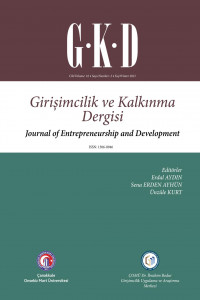Öz
Dış ticaret, bir ülkenin ekonomik büyüme süreci üzerinde belirleyici rol oynadığından ülkeler için önemli makro ekonomik değişkenlerden birisidir. Dış ticaretin önemi 1973 yılında Bretton Woods sisteminin çökmesi ile başlayan küresel serbestleşme (malların, sermayenin ve kişilerin serbest dolaşımı) süreci ile birlikte daha da artmıştır. Dış ticaretin en önemli belirleyicilerinden birisi döviz kurudur. Döviz kurunun dış ticaret ile olan etkileşimi dış ticaretten elde edilecek kazanç ve kayıpları etkilemektedir. Çalışmanın amacı; 1996-2018 döneminde BRICS-T (Brezilya, Rusya, Hindistan, Çin, Güney Afrika ve Türkiye) ülkelerinde döviz kurunun dış ticaret üzerindeki etkisini Panel Veri Analizi yöntemiyle analiz etmektir. Çalışmanın bulguları döviz kuru, kişi başına gelirdeki büyüme ve enflasyon ile dış ticaret dengesi arasında istatistiki olarak anlamlı bir ilişki ve pozitif yönlü bir etki olduğunu göstermektedir.
Anahtar Kelimeler
Kaynakça
- AKBOSTANCI, E. (2002). “Dynamics of theTradeBalance: TheTurkish J-Curve”, ERC WorkingPapers in Economics, 1(5): 1-19.
- BAHMANI, M., HARVEY, H., and HEGERTY, S. W. (2013). “Empiricaltests of the Marshall‐Lerner condition: a literature review”, Journal of Economic Studies.
- BARAK, D. ve NAİMOĞLU, M. (2018). “Reel Döviz Kurunun Dış Ticaret Üzerindeki Etkisi: Kırılgan Beşli Örneği”, Ömer Halisdemir Üniversitesi İktisadi ve İdari Bilimler Fakültesi Dergisi, 11(2): 82-95.
- BAYAR, Y. (2017). “Yükselen Piyasa Ekonomilerinde Emeklilik Fonları, Finansal Gelişme ve Ekonomik Büyüme: Bir Panel Nedensellik Analizİ”, BDDK Bankacılık ve Finansal Piyasalar, 11(1): 51-64.
- BREUSCH, T and PAGAN, A. (1980). “The LM Test andIts Applications to Model Specification in Econometrics”. Review of Economic Studies, 47: 239-254.
- CHRİSTENSEN, C. (2012). “TheEffect of GDP & Exchange Rate on the Trade Balance Between The United States and Mexico”, Proceedings of the National Conferences on Undergraduate Research, (Utah, 29 –31 March 2012), 670-680.
- DUMİTRESCU, E. and HURLİN, C. (2012). “Testing for Granger Non-Causality in Heterogeneous Panel”, Economic Modelling, 29(4): 1450-1460.
- HADRİ, K. (2000). “Testing for stationarity in heterogeneous panel data”. The Econometrics Journal, 148-161.
- HADRİ, K. and KUROZUMİ, E. (2012). “A Simple Panel Stationarity Test in the Presence of Serial Correlationand a Common Factor”, Economics Letters, 115: 31-34.
- HOOPER, P. and KOHLHAGEN, S. (1978). “The Effect of Exchange Rate Uncertainty on the Pricesand Volume of International Trade”, Journal of International Economics, 8(4): 483–511.
- KANG, J.W. and SUZETTE, D. (2018) “International trade and Exchange rates”, Journal of Applied Economics, 21(1): 84-105.
- KARAGÖZ, M. and DOĞAN, Ç. (2005). “Döviz Kuru Dış Ticaret İlişkisi: Türkiye Örneği”. Fırat Üniversitesi Sosyal Bilimler Dergisi, 15(2): 219-228.
- KHATOON, R., HASAN, M. E., IBON, M. W. F., ISLAM, S., MEHAREEN, J., MURSHED, R., and SHUCHI, M. S. (2021). “Aggregation, asymmetry, and common factors for Bangladesh’s exchange rate–trade balance relation”, Empirical Economics, 1-32.
- KORAY, F. and LASTRAPES, W. D. (1989). “Real Exchange Rate Volatility and U.S. Bilateral Trade: A Var Approach”, The Review of Economics and Statistics, 71(4), 708-712. KORBI, A.; BANUSHAJ, B. (2021). “Relationship Between Exchange Rate and Trade Balance: The Case of Albania”, In Book Of Proceedings, 299.
- KREUGER, A.D. (1983). Exchange Rate Determination. Cambridge: Cambridge University Press.
- KRUGMAN, P. R. and OBSTFELD, M. (2003). International Economics: Theory and Policy. 6th Edition. Boston: Addison Wesley Publishing Company.
- LIEW, K. S., LIM, K. P., and HUSSAIN, H. (2003). “Exchange rate and trade balance relationship: The experience of ASEAN countries”, International Trade, 307003: 1-11.
- MAHDAVİ, S. and SOHRABİAN, A. (1993). “The Exchange Rate Values of the Dollar and the U.S. Trade Balance: An Empirica lInvestigation Based on Cointegration and Granger Causality Tests”, The Qliarrerly Review of Economics and Finance,33(4): 343-358.
- NİSHİMURA, Y. and HİRAYAMA, K. (2013). “Does Exchange Rate Volatility Deter Japan-China Trade? Evidence from Pre- and Post-Exchange Rate Reform China”, Japan and The World Economy, 25(26): 90-101.
- PALEOLOGOS, J. M. and GEORGANTELİS, S. E. (1997). “Exchange Rate Movements and the Trade Balance Deficit: A Multivariate Cointegration Analysis”, International Economics, Cameradi Commercio Industria Artigianato Agricolturadi Genova, 50(3): 459-470.
- PESARAN M. H. and YAMAGATA, T. (2008). “Testing Slope Homogeneity in Large Panels”, Journal of Econometrics, 142: 50–93.
- PETROVIĆ, P. and GLIGORIĆ, M. (2010). “Exchange Rate and Trade Balance: J-Curve Effect”, Panoeconomicus, 57(1): 23-41.
- ROSE, A. K.A and YELLEN, J. L. (1989). “Is there a J-curve?”, Journal of Monetary economics, 24(1): 53-68.
- ROSE, A. K. (2000). “One Money, One Market: Estimating the Effect of Common Currencies on Trade”, Economic Policy, 15(30): 7-46.
- WORLD POPULATION REVIEW (2021). https://worldpopulationreview.com/, 15.05.2021.
- WORLD BANK (2020). “Worldwide Governance Indicators (WGI) Project”, http://info.worldbank.org/governance/wgi/index.aspx#home, 03.03.2020
Ayrıntılar
| Birincil Dil | Türkçe |
|---|---|
| Bölüm | Makaleler |
| Yazarlar | |
| Erken Görünüm Tarihi | 31 Aralık 2021 |
| Yayımlanma Tarihi | 31 Aralık 2021 |
| Gönderilme Tarihi | 4 Ekim 2021 |
| Yayımlandığı Sayı | Yıl 2021 Cilt: 16 Sayı: 2 |


